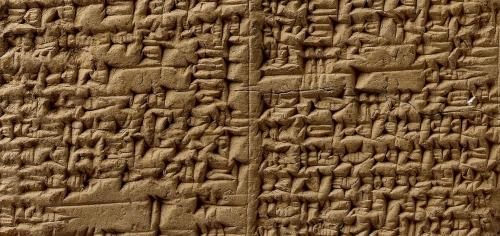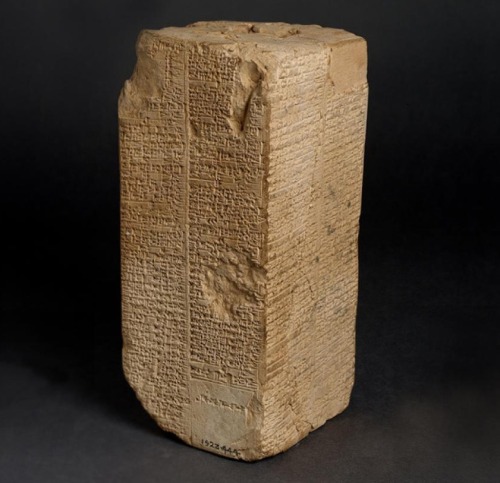Sumerian King List (c. 1800 BC), probably found at Larsa.This clay prism (20 x 9cm) is inscribed on
Sumerian King List (c. 1800 BC), probably found at Larsa.This clay prism (20 x 9cm) is inscribed on each side with two columnsof cuneiform script in the Sumerian language. It lists a successionof cities in Sumer and its neighbouring regions, their rulers, andthe lengths of their reigns. Several versions of the Sumerian KingList have been found, but this is the most extensive and the mostcomplete.The first Sumerian King List was written by a scribe of Lagash around2100 BC (during the Early Dynastic Period of Mesopotamia). It wasprobably created to legitimize the reign of Utu-hengal of Uruk, byshowing him as the most recent in a long line of rulers of theregion. The list shows continuity of order in society, dating backto the beginning of civilization, when according to Sumerian beliefs,the gods first established the kingship at Eridu.The Sumerian King List begins with the antediluvian (pre-flood)rulers, none of which are archaeologically attested. It goeschronologically down from Alulim (who is said to have ruled for28,800 years) down to Utu-hengal.Etana of Kish (halfway down the First Dynasty of Kish, which followsthe antediluvian rulers) is the first king whose deeds are recordedin any way. He may have taken the throne quite early in the 3rdmillennium BC (during the Uruk Period). The lists claims that heruled for 1,560 years (other versions say 635 years).The mythical Etana was a man who ascended to heaven on the back of aneagle. He was known for superhuman feats and heroism, like otherkings on the list such as Dumuzid and Gilgamesh. Utu-hengal wasprobably trying to link himself to earlier such hero-kings.Mesopotamians believed that the gods had set everything in motion,and that they’d created humans as co-labourers to help maintain orderand hold back chaos. Therefore, early Sumerian writers of historyfocused more on the links between rulers and gods, rather than actualhuman accomplishments. Because of this, the early history of Sumerrelies greatly on geological and archaeological records, and there ismuch still unknown. -- source link
Tumblr Blog : mostly-history.tumblr.com
#history#politics#languages#sumerian mythology#uruk period#mesopotamia#sumer#lagash#uruk#kish#iraq#utu-hengal#sumerian language#cuneiform#sumerian cuneiform



